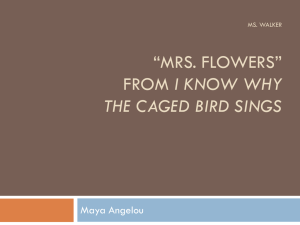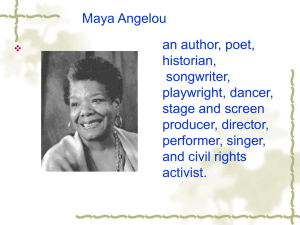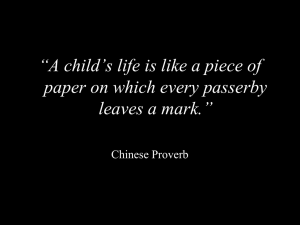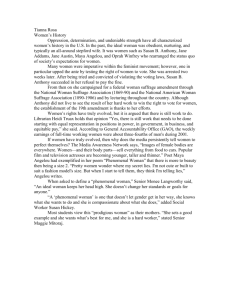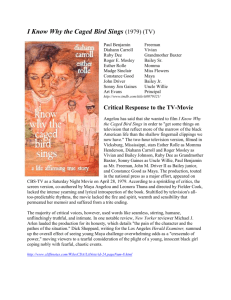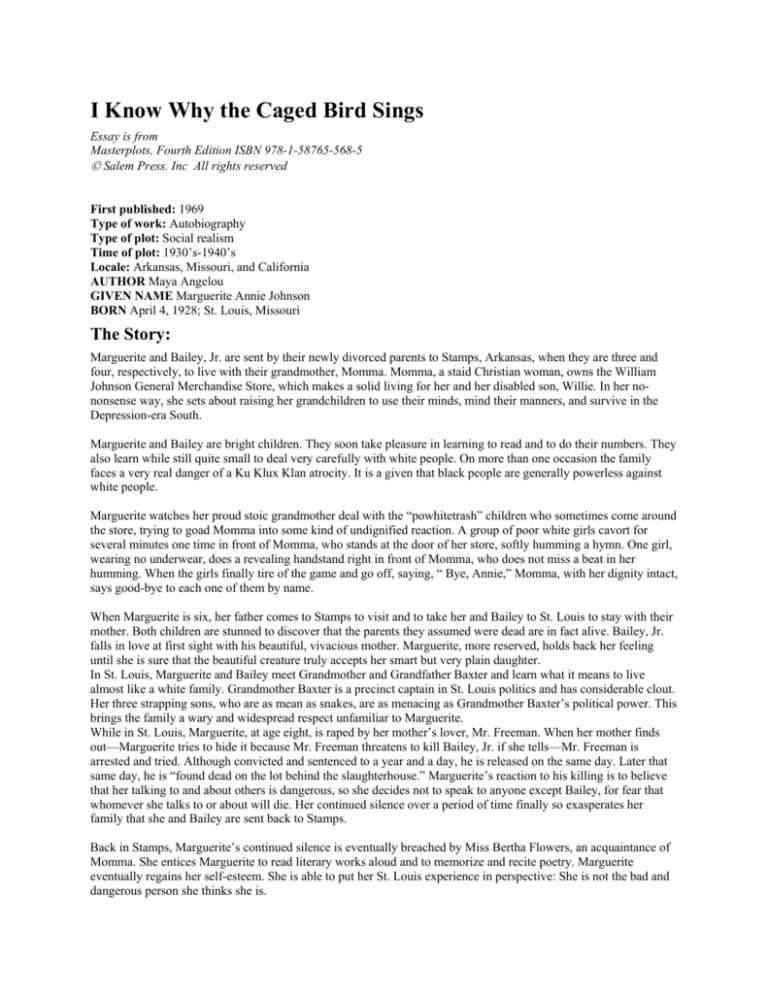
I Know Why the Caged Bird Sings
Essay is from
Masterplots, Fourth Edition ISBN 978-1-58765-568-5
Salem Press. Inc All rights reserved
First published: 1969
Type of work: Autobiography
Type of plot: Social realism
Time of plot: 1930’s-1940’s
Locale: Arkansas, Missouri, and California
AUTHOR Maya Angelou
GIVEN NAME Marguerite Annie Johnson
BORN April 4, 1928; St. Louis, Missouri
The Story:
Marguerite and Bailey, Jr. are sent by their newly divorced parents to Stamps, Arkansas, when they are three and
four, respectively, to live with their grandmother, Momma. Momma, a staid Christian woman, owns the William
Johnson General Merchandise Store, which makes a solid living for her and her disabled son, Willie. In her nononsense way, she sets about raising her grandchildren to use their minds, mind their manners, and survive in the
Depression-era South.
Marguerite and Bailey are bright children. They soon take pleasure in learning to read and to do their numbers. They
also learn while still quite small to deal very carefully with white people. On more than one occasion the family
faces a very real danger of a Ku Klux Klan atrocity. It is a given that black people are generally powerless against
white people.
Marguerite watches her proud stoic grandmother deal with the “powhitetrash” children who sometimes come around
the store, trying to goad Momma into some kind of undignified reaction. A group of poor white girls cavort for
several minutes one time in front of Momma, who stands at the door of her store, softly humming a hymn. One girl,
wearing no underwear, does a revealing handstand right in front of Momma, who does not miss a beat in her
humming. When the girls finally tire of the game and go off, saying, “ Bye, Annie,” Momma, with her dignity intact,
says good-bye to each one of them by name.
When Marguerite is six, her father comes to Stamps to visit and to take her and Bailey to St. Louis to stay with their
mother. Both children are stunned to discover that the parents they assumed were dead are in fact alive. Bailey, Jr.
falls in love at first sight with his beautiful, vivacious mother. Marguerite, more reserved, holds back her feeling
until she is sure that the beautiful creature truly accepts her smart but very plain daughter.
In St. Louis, Marguerite and Bailey meet Grandmother and Grandfather Baxter and learn what it means to live
almost like a white family. Grandmother Baxter is a precinct captain in St. Louis politics and has considerable clout.
Her three strapping sons, who are as mean as snakes, are as menacing as Grandmother Baxter’s political power. This
brings the family a wary and widespread respect unfamiliar to Marguerite.
While in St. Louis, Marguerite, at age eight, is raped by her mother’s lover, Mr. Freeman. When her mother finds
out—Marguerite tries to hide it because Mr. Freeman threatens to kill Bailey, Jr. if she tells—Mr. Freeman is
arrested and tried. Although convicted and sentenced to a year and a day, he is released on the same day. Later that
same day, he is “found dead on the lot behind the slaughterhouse.” Marguerite’s reaction to his killing is to believe
that her talking to and about others is dangerous, so she decides not to speak to anyone except Bailey, for fear that
whomever she talks to or about will die. Her continued silence over a period of time finally so exasperates her
family that she and Bailey are sent back to Stamps.
Back in Stamps, Marguerite’s continued silence is eventually breached by Miss Bertha Flowers, an acquaintance of
Momma. She entices Marguerite to read literary works aloud and to memorize and recite poetry. Marguerite
eventually regains her self-esteem. She is able to put her St. Louis experience in perspective: She is not the bad and
dangerous person she thinks she is.
By the time Marguerite graduates from the eighth grade, she has acquired her first real friend, Louise Kendricks.
Bailey has his first sexual relationship with an older girl, who teaches him to steal from Momma’s store and who
ultimately runs off to marry a railroad man.
Momma decides that Marguerite and Bailey, now in their teens, should go to live with their parents, who both live in
California. World War II has started, and black folks are moving into California neighborhoods recently vacated by
interned Japanese Americans. Marguerite and Bailey adapt well to their new life. She spends a summer in Southern
California with her father. He takes her on an overnight trip to Mexico, which causes a fight between Marguerite and
his fiancé. Marguerite runs away and for a month lives in a junkyard with other homeless children. She finally
returns to her mother’s home, none the worse for her experiences.
Bailey becomes so “mannish” that his mother orders him to leave her house. When he does, Marguerite begins to
feel the need to be more independent. She gets a job, becoming the first African American conductorette on a San
Francisco streetcar. School loses much of its charm, but she recognizes the need to finish high school.
At this time, also, Marguerite begins to worry about her femininity. Her body has few of the contours of a sixteenyear-old. She begins to think she might be a lesbian. To prove to herself that she is not, she seduces a neighbor boy
and gets pregnant. No one is aware, though, even as she graduates from high school with only about a month before
the baby is due. She finally tells her mother about the impending birth. Her family rallies around her and she gives
birth to a son.
Critical Evaluation:
I Know Why the Caged Bird Sings has been called an autobiography by some and a novel by others. Organized
episodically, it moves chronologically from the early 1930’s through the early 1940’s. It begins when Marguerite
and Bailey are three and four and ends just after V-Day and Marguerite’s high school graduation. In describing what
happens to the main character, Marguerite Johnson, it shows what happens in the black communities of Stamps,
Arkansas; St. Louis; and parts of wartime California.
Autobiographical elements include what happens to Marguerite and her family and how she feels, as an adult, about
the people and events. The novelistic elements include her graphic and detailed reconstruction of long-past events
and conversations. The resulting work creates a character in Marguerite who is intelligent, curious, perceptive, and
fascinated by all kinds of things. What she endures, the events and people who touch her life, are blended into a
mélange of appealing stories.
Nearly every episode seems to have at least one of two aims—to give a picture of what it was like to be an African
American during the Great Depression and World War II, and to show how one very determined black girl faced
obstacles, overcame them, and triumphed. The dangers of being black in the days before the civil rights struggle are
illustrated in the episode in which crippled Uncle Willie must hide all night in a compartment of the store’s potato
bin because the Ku Klux Klan is on the rampage. Another episode shows Marguerite working as a maid in a white
household and being called “Mary” because the white mistress of the house decides “Marguerite” is too much name
for her to have to say. When the entire black community of Stamps gathers around the store’s radio to hear the Joe
Louis-Primo Carnera fight, Maya Angelou re-creates the pride blacks felt in their hero. When it seems that Louis
might lose, she writes, “my race groaned. It was our people falling. . . . A Black boy whipped and maimed . . .
hounds on the trail of a man . . . a white woman slapping her maid. . . . We didn’t breathe. We didn’t hope. We
waited.” Then when Louis knocks out his white opponent and is announced “still heavyweight champion of the
world,” the black people of Stamps, clearly representative of black people all over America, celebrate. Another time,
when Marguerite has a bad toothache, her grandmother takes her to the only dentist in Stamps, a white man to whom
Momma lent money during the Depression. He refuses to help, saying, “I’d rather stick my hand in a dog’s mouth”
than in the mouth of any black person. Angelou’s reaction is to fantasize that her grandmother gets revenge by
humiliating the dentist and putting him out of business. These and other episodes depict many aspects of the black
experience, enhancing what may be conveyed blandly in history books.
Angelou’s affinity for poetry is evident in her writing style, full of poetic imagery and unusual phraseology. She
mixes African American sayings and idioms to achieve her own inimitable mode of expression. The book begins
with the African American rhyme, “What you looking at me for?/ I didn’t come to stay./ I just came to tell you,/ it’s
Easter Day.” She describes “the kissing sounds of the tires” on her father’s car as they drive to St. Louis. A summer
afternoon is recalled as “sweetmilk fresh in [her] memory.” Vomiting is described as “My lunch was in my mouth a
second time.”
Some figures of speech are not successful. They sometimes require rereading to grasp the intent. Angelou, for
example, describes a set of false teeth as “looking empty—and at the same time appearing to contain all the
emptiness in the world.” However, for the most part, the language of the narration and of the dialogue is fresh, vivid,
and characteristic of twentieth century African American expression.
Angelou’s kind of black family is not often the subject of literature. Her grandparents on both sides are not only
hard-working but successful. Hard work has often been shown as the lot of black people, particularly before the
1960’s. Almost always, the result of their labor was minimal subsistence. The Johnsons and the Baxters not only
made a good living, they were also in a position to help others. They are seen as realizing to a great extent the
American Dream, and Angelou shows herself and her brother Bailey as growing up with the American Dream of
being educated and successful.
I Know Why the Caged Bird Sings does for the southern rural black experience what James Baldwin’s Go Tell It on
the Mountain (1953) does for the northern urban black experience. Its historical commentary is instructive about the
Depression in the south. The portrayal of a young woman’s search for identity is unforgettable.
Further Reading
Angelou, Maya. Conversations with Maya Angelou. Edited by Jeffrey M. Elliot. Jackson: University Press
of Mississippi, 1989. An excellent collection of interviews with Angelou, arranged chronologically from
1971 to 1988. Contains a useful introduction, a chronology, and an index as well as photographs of
Angelou.
Bloom, Harold, ed. Maya Angelou’s “I Know Why the Caged Bird Sings.” Philadelphia: Chelsea House,
2004. Includes a brief biography of Angelou, plot summary, and essays providing analyses and critiques of
the book. In addition, it contains a list of characters and an annotated bibliography.
Braxton, Joanne M. Black Women Writing Autobiography: A Tradition Within a Tradition. Philadelphia:
Temple University Press, 1989. Argues that Angelou uses the child’s vision as principle of selection and
the protecting mother as primary archetype, bringing to fruition certain themes of black female
autobiography: the importance of family and of rearing one’s children, resistance to a hostile environment,
sympathy, and self-definition.
_______, ed. Maya Angelou’s “I Know Why the Caged Bird Sings”: A Casebook. New York: Oxford
University Press, 1999. Contains several essays analyzing the book, including discussions of its
representation of rape, racial identity, and racial protest; death as metaphor of self; and Angelou and
autobiographical continuity. Includes an interview with Angelou conducted exclusively for this book.
Demetrakopoulos, Stephanie A. “The Metamorphosis of Matrilinearism in Women’s Autobiography.” In
Women’s Autobiography, edited by Estelle C. Jelinek. Bloomington: Indiana University Press, 1980. I
Know Why the Caged Bird Sings is one of four modern women’s autobiographies analyzed.
Hagen, Lyman B. Heart of a Woman, Mind of a Writer, and Soul of a Poet: A Critical Analysis of the
Writings of Maya Angelou. Lanham, Md.: University Press of America, 1997. One of the chapters provides
a general analysis of Angelou and autobiography, while individual chapters examine I Know Why the
Caged Bird Sings and her other autobiographical works.
MacKethan, Lucinda H. “Mother Wit: Humor in African-American Women’s Autobiography.” Studies in
American Humor 4 (Spring/Summer, 1985): 51-61. Notes that empowerment through the acquisition of
language and the development of verbal humor are unifying themes in Angelou’s autobiography.
McPherson, Dolly A. Order Out of Chaos: The Autobiographical Works of Maya Angelou. New York:
Peter Lang, 1990. Examines the organization of Angelou’s autobiographical works around certain recurring
themes. An addendum contains an insightful and illuminating interview with Angelou that sheds new light
on I Know Why the Caged Bird Sings.
Megna-Wallace, Joanne. Understanding “I Know Why the Caged Bird Sings”: A Student Casebook to
Issues, Sources, and Historical Documents. Westport, Conn.: Greenwood Press, 1998. Designed to help
high school and undergraduate students better understand Angelou’s book. Contains literary criticism and
information about race relations in the south, the African American church and family, and sexual abuse.
The book’s primary sources include letters, and newspaper reports. Includes, also, study questions, ideas
for school projects, and bibliographies for further reading.
Tate, Claudia. “Maya Angelou.” In Black Women Writers at Work. New York: Continuum, 1983. Angelou
talks about the special need of black American women to make images of themselves and to have positive
role models. She also discusses her responsibility as a writer and her writing process.

